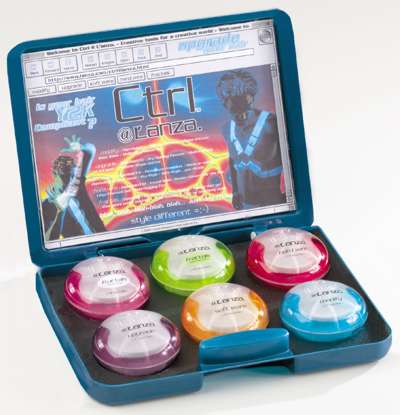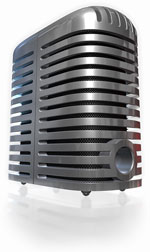![]()
The Mac Set
Mac Set home | Archive Index | Archive 1 | Archive 2 | Archive 3 | Archive 4 | Archive 5 | Archive 6 | Altivec Performance Comparison Table
Archive 5
Travel The iMac Way
11 March 2000.
| These scooters were to be found at a motor show... or a computer show... or something... last November. Now you too can travel in iMac style. |  |
Hair-raising Laptop
11 March 2000.
Yes, it's designer hair gel - in iMac colours. Released last November.

Apple Wins Again
21 March 2000.
The United States District Court for the Southern District of Iowa has dismissed Microware Systems Corporation's lawsuit seeking to enjoin Apple from using the name "Mac OS 9" for its current operating system release.
In dismissing the case, the court held that Apple is entitled to use the Mac® OS 9 name under the doctrine of "fair use". The court also issued an order denying Microware's motion for a preliminary injunction.
Mac Stands Firm
25 March 2000.
The US Army switched to using Mac G3 Web servers running WebSTAR to host its main site, citing security concerns with Microsoft servers. But yesterday the army's servers were attacked by Brazillian hackers.
The hackers were from a group called Crime Boys. The Web sites hacked were http://www.cpma.apg.army.mil and http://www.2rotc.army.mil.
The Mac servers withstood the attack, but two Windows NT servers running Microsoft-IIS/4.0 were broken into. The hacked site has already been removed.
Star Wars' Preference
22 June 2000.
There's much politicing that goes on in the platform wars. This from an anonymous, supposedly-Adobe source regarding Industrial Light and Magic:
The reason JAK and ILM have been quiet about their use of Macs is they've got this deal with SGI where SGI provides them with free machines in return for they're NEVER saying they use Macs. In the end, they did come out and say they use Macs for "pre-visualization" which is true, but far from the whole truth. In fact, there were many, many scenes where the FINAL render was done on Macs, using After Effects and other 3D software. I don't want to bust up the nice deal Lucas has with SGI, but I do want people to know they can make real movies on their Macs using off the shelf software.
Applemaster Michael Crichton
1 July 2000.
 On the ease of setting up a Macintosh network, Applemaster and
author Michael Crichton has this to say:
On the ease of setting up a Macintosh network, Applemaster and
author Michael Crichton has this to say:
Even my most dedicated PC friends questioned their beloved technology when they tried to install home networks in the 1990s. It took them days, and often they had to cry for help. I, on the other hand, had installed and maintained my own networks since the '80s. (It was about as difficult as plugging in a toaster, which I also do myself, without expert help.)
And on designing simplicity into a product:
I once had a kitchen stove where the six burner knobs were identical, arranged in a straight row along the front. I could never remember which knob controlled which burner. I had to turn the knobs and watch which burner came on.
Eleven years later, I still hadn't learned. Because I don't think I should have to use my thinking time to memorize the controls for a gas stove. The stove designer should take care of that for me.
My parents have a double switch in their dining room. One controls the dining room light while the other switches the lounge light. They are unlabelled, and more than 25 years later people still flick the wrong switch because they are simply the wrong way around. PC-loving father refuses to let them be rewired.
For more, read Mr Crichton's Applemaster pages.
More Reasons Why
30 July 2000.
Why Macs are better than PCs reason 34,576:
Mac icons use the full 256 system colours - PC icons can use only 16 present colours. This means that Mac icons can use shading, leading to almost photo-realistic... ummm... photos for icons (which almost all of my many homemade icons are). And just by chance, the Firelab director just today was criticising PC icons because they're so badly drawn and often hard to understand. (And compared to Mac icons they really are ugly and clunky looking.)
Why Macs are better than PCs reason 34,577:
Mac mice use acceleration - a non-linear speed relation between the mouse speed and the cursor speed. PC mice have a linear relationship which can be set anywhere from almost useable to frenetic. The fine control required by designers and publishers (while still having a practical speed at larger mouse movements) make it clear why such a subtle effect helps make Macs so popular with that group.
Initial experiments with my own Mac mouse show better than a 4:1 acceleration ratio. When I move the mouse slowly I can move it all the way across my mousepad while the cursor moves less than half way across the screen. When I move the mouse quickly I move the mouse half way across the mousepad for completely traversing the screen. (The customisable control panel indicates 8 different speed steps/multipliers.)
Overclocked Mac
11 August 2000.
 |
1200MHz G4 aftermarket Macintosh from a Value Added Reseller (VAR) named Xtrem supposedly ready by the end of the year. No-one knows if it's for real yet, but the theory is sound. Overclock a 500MHz G4 to run at 1200MHz using Peltier devices and liquid cooling. (Yep.) The case is polished aluminium, allegedly to help cool it - and of course make it look like an overgrown microphone. The hole in the front is for a lurid green light. There aren't any actual photos yet (just high quality CGI), and no tech specs, which are two good reasons why some think it's a hoax. (Very elaborate one, though.) It's probably more wishful thinking than a deliberate hoax. |
Mac in Space
28 October 2000.
SkyCorp has signed an agreement with NASA to fly the first web server in space. The cool part: The Web server will be a PowerMac G4 running Mac OS X Server.
The satellite's computer will use a G4 500 Mhz processor running OSX with a webserver running under Apache. The server will have 10 GB of storage space and will be hosting up to several thousand websites. The server will also have a mail server that will allow people to get email directly from space.
The SkyCorp satellite will use the 802.11 Direct Sequence Spread Spectrum (DSSS) worldwide industry standard, and will be accessible for operations purposes at up to 11 Mb/sec. This protocol is the core of Apple's AirPort wireless technology developed jointly by Apple and Lucent Technologies. For end users on the ground, Wingo says that 56kbps speeds will be available to people with wireless devices - when the satellite is overhead.
Mac World San Fransisco 2001
29 November 2000.
Just over a month to go before Macworld San Francisco in early January 2001. Among the expected announcements:
Software:
- Release of Mac OS 9.1.
- Release of QuickTime 5.0.
- A firmer timetable for Mac OS X 1.0 along with extensive previews
of new features in latest build(s).
- Delayed until March/April: Release of two new Apple multimedia
applications; one is confirmed to be a new DVD Authoring app, the other
is still a matter of disagreement.
- Oracle is expected to announce plans to release their 9i database
for OS X.
- Numerous developers, including some surprising new faces, trotted out to trumpet support for Mac OS X.
Apple Hardware:
Evidence that the entire Mac range will be upgraded is Apple's mail-in rebate for extra memory, valid until 31 December 2000. The offer gives US$1 off for each extra MB, which means buying a little extra memory with a computer makes the computer cheaper in total than the standard configuration. This is not being pushed as a Christmas special, but some voices claim the discount is merely to try to increase waning sales, not decrease old inventory for new releases in the new year.
- 466, 533 and 600MHz G4s in PowerMac line, although possibly speeds
of only 400, 466, 533MHz. UMA-2 motherboards, adding DDR SDRAM support
at 133MHz. All speeds with dual processors.
Indirect evidence is the price drop for the Cube/monitor bundle (see below), indicating a Cube upgrade. Apple would not have faster CPUs in the Cube than in the PowerMac - the top of the range Mac.
- Powerbook G4. UMA-2 motherboard chipset with 4X AGP graphics, ATi
RAGE Mobility M4 accelerators, ATA-100 storage, and many other new features.
Possibly a 15" 1600 x 1024 widescreen.
Evidence of a big update is a second-hand report of Apple Australia's prize for its current buy-a-PowerMac competition. Quote the conditions of entry:"8) The major prize is an Apple PowerBook G4 computer valued at [AU]$4,700."
Also, Apple is offering US$200 off PowerBooks until 31 December (mail-in rebate). Apple has also quietly reduced the price on its high-end 500MHz PowerBook by US$500, with a new minimum advertised price of $2999 (128MB/20GB). Unknown at this stage if this second reduction is permanent (ie, if it will apply to January's model). Meanwhile, in New Zealand, Apple is offering a NZ$400 rebate on the 400MHz, and a NZ$1450 rebate on the 500MHz model. Similar rebates are being offered by Apple Aus.
- 533 and 600MHz G4s added to Cube line, although possibly only 466
and 533MHz. UMA-2 motherboards, adding DDR SDRAM support at 133MHz.
Evidenced by Apple offering US$300 back on Cube/monitor bundle.
- Delayed until March/April: "Cube Portable" whose
shipping name is rumored to follow none of the current schemes (iMac/iBook,
PowerMac/Powerbook, Cube). UMA-2 motherboard chipset with 4X AGP graphics,
ATi RAGE Mobility M4 accelerators, ATA-100 storage, and many other new
features.
- Updates to iMac lineup with faster IBM PowerPC 750CX/750CXe low-power G3 processors and UMA-2 chipset. Possible price reductions across the board.
Non-Apple Hardware:
- ATi expected to release RADEON MAXX dual-processor AGP graphics
card with up to 128MB of DDR video memory for Apple's PowerMac G4 and
G4 Cube; if Apple makes the planned update to UMA-2 for both of those
machines at MWSF, the cards will likely be 4X AGP.
- nVidia expected to release Mac version of GeForce MX and possibly
high-end GeForce256.
- Formac is expected to demonstrate its forthcoming ProFormance IV, with 64MB of SGRAM, dual 128-bit rasterization processors and an additional geometry processor on a dual-monitor-capable 2X AGP card. Support for 3D goggles.
Mac Set home | Archive Index | Archive 1 | Archive 2 | Archive 3 | Archive 4 | Archive 5 | Archive 6 | Altivec Performance Comparison Table
Contact:
Return to ianman HOME | Return
to top
